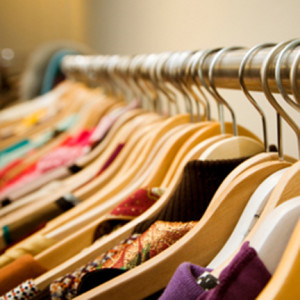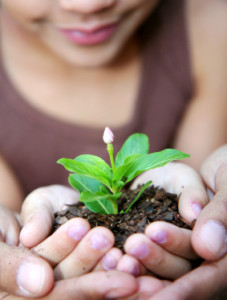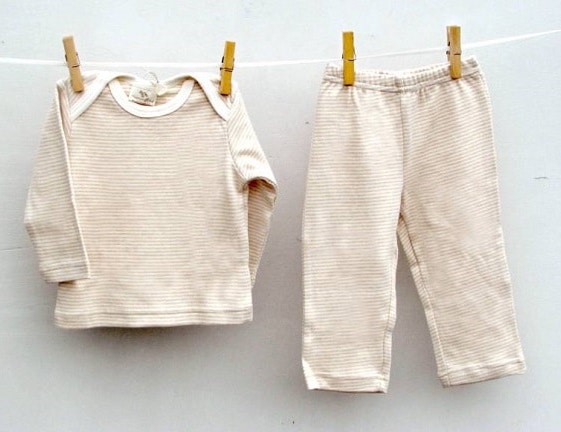“ALL of my clothes must go!” I shouted from my heart, as I flung clothes like acrobats through the air. For most people, their loads of clothes are tucked away in the closet. For me, my clothes were staring me straight in the face every time I packed up my life in my little white car. It has been 7 months since I hit the road on my path to creating new paradigm communities through Harmonious Earth. I’d given away a lot of my clothes after making the decision to leave Los Angeles, but after several months it didn’t make sense to keep my Fendi heels to wear in a rugged Maui jungle. I had been a classic female adorer of clothes all my life, but my relationship with the world has changed and the way I viewed clothes has naturally transitioned with it.
 Many of us are becoming more aware and conscious of ourselves and the world around us. For me, once I discover one eco-solution or holistic way of doing something, it always leads to the next thing to unravel in my life… it’s like an unending rabbit hole of change!! We can see people shifting to local, organic non-GMO produce, recycling, getting solar panels and even affordable electric cars are now on the market! One of the segments that’s rarely talked about, in terms of sustainability and health, is clothing!! Health and clothing go together? Well, after I dove in and learned, you’ll be shocked about how the two are intertwined!
Many of us are becoming more aware and conscious of ourselves and the world around us. For me, once I discover one eco-solution or holistic way of doing something, it always leads to the next thing to unravel in my life… it’s like an unending rabbit hole of change!! We can see people shifting to local, organic non-GMO produce, recycling, getting solar panels and even affordable electric cars are now on the market! One of the segments that’s rarely talked about, in terms of sustainability and health, is clothing!! Health and clothing go together? Well, after I dove in and learned, you’ll be shocked about how the two are intertwined!
1. Know What You’re Wearing
Most of us, if you were drawn to read this blog, are aware or fickle about pesticides in your food or the chemicals from plastic water bottles leaching — affecting the hormones in our bodies. Now imagine a highly absorbent part of our bodies taking in chemicals… the biggest organ in the body — the skin!!
With the introduction and shift of synthetic fibers replacing natural ones beginning in the early and mid-20th century such as rayon, nylon, acrylic, polyester and spandex, our health has gone with it. According to Brian R. Clement, author of Killer Clothes, “Human-made petrochemical fibers (from fossil fuels) restrict and suffocate the skin, our largest and most sensitive body organ, making it unable to breath properly so it can release toxins…. and it’s estimated that we release a pound of toxins through our skin every day.” Some synthetic fibers are even banned by US troops due to the high levels of flammability in clothes we have in our closet!
 The highly toxic chemical formaldehyde (linked to cancer and leukemia) and dyes used in processing and created fabrics are handled as a toxic waste. China, which makes up three-fourths of the clothing sold in the US per year, permits generous levels of formaldehyde in the production of their clothes and the United States uses “voluntary” standards. Even small exposure to these chemicals over time can produce adverse effects such as headaches, asthma, lung damage, infertility and even cancer. Conventionally Grown Cotton consumes 50% of the pesticides sprayed in the entire world. In addition to the growing, harvesting, cleaning and manufacturing of conventional cotton uses a variety of toxic chemicals and oils to prepare it for spinning. We expose our skin and bodies to these chemicals, wearing them every day.
The highly toxic chemical formaldehyde (linked to cancer and leukemia) and dyes used in processing and created fabrics are handled as a toxic waste. China, which makes up three-fourths of the clothing sold in the US per year, permits generous levels of formaldehyde in the production of their clothes and the United States uses “voluntary” standards. Even small exposure to these chemicals over time can produce adverse effects such as headaches, asthma, lung damage, infertility and even cancer. Conventionally Grown Cotton consumes 50% of the pesticides sprayed in the entire world. In addition to the growing, harvesting, cleaning and manufacturing of conventional cotton uses a variety of toxic chemicals and oils to prepare it for spinning. We expose our skin and bodies to these chemicals, wearing them every day.
In short, the mainstream clothes being made are not healthy and in some cases, aren’t even safe for us to be wearing. After researching this information, I went through the clothes I had left and 90% of them didn’t even come close to making the “health” cut. Again, what I’m sharing here is a holistic approach that we can transition to in our own timing — from our food to our lifestyles to our clothes. There are a lot more details on the subject and I’ve linked to some great resources at the bottom of this post if you’d like to take a deeper look.
2. Gather the Solutions
There are many organic natural fibers out there today including flax, wool, silk, angora, cashmere, etc. I’m going to focus on the most sustainable, affordable, stylish, plant-based fabrics that are readily available solutions for mainstream buyers. The areas to consider when understanding the sustainability and health of a fabric is how the raw material is grown and how it is manufactured/processed.
 Hemp is one of the most ecologically friendly fabrics on Earth! It’s extremely durable, long lasting, insulative, breathable, biodegradable and very absorbent. Hemp is low in lignin, needing few chemicals for processing and making it more absorbent to dyes. Unfortunately the cultivation of hemp is illegal in the US (it just became legalized to grow in Colorado this week!), but hemp products and clothing are legal to buy and are primarily from China, which has naturally cultivated the plant for thousands of years.
Hemp is one of the most ecologically friendly fabrics on Earth! It’s extremely durable, long lasting, insulative, breathable, biodegradable and very absorbent. Hemp is low in lignin, needing few chemicals for processing and making it more absorbent to dyes. Unfortunately the cultivation of hemp is illegal in the US (it just became legalized to grow in Colorado this week!), but hemp products and clothing are legal to buy and are primarily from China, which has naturally cultivated the plant for thousands of years.
 Organic Cotton is a versatile fiber that is breathable, durable and highly absorbent which is why it’s so extensively used around the world! Organically grown and manufactured cotton is an unconventional “art-form” of sorts with only approximately 10,000 acres in the US dedicated to organic cotton. This fabric is a healthy, feel good solution.
Organic Cotton is a versatile fiber that is breathable, durable and highly absorbent which is why it’s so extensively used around the world! Organically grown and manufactured cotton is an unconventional “art-form” of sorts with only approximately 10,000 acres in the US dedicated to organic cotton. This fabric is a healthy, feel good solution.
 Flax – Linen is a a durable and notoriously breathable natural fiber. It is 2-3 times stronger and smoother than cotton fabric and due to the weave of the fibers, allows for airflow creating an anti-clinging fabric that allows moisture to escape. It requires less water and chemicals than other fabrics to be cultivated and processed. It’s durability leads to long-lasting uses for bedding, curtains and clothes.
Flax – Linen is a a durable and notoriously breathable natural fiber. It is 2-3 times stronger and smoother than cotton fabric and due to the weave of the fibers, allows for airflow creating an anti-clinging fabric that allows moisture to escape. It requires less water and chemicals than other fabrics to be cultivated and processed. It’s durability leads to long-lasting uses for bedding, curtains and clothes.
 Bamboo is the fastest growing grass on earth, and doesn’t require replanting after harvest or pesticides to grow. Bamboo fabric is known for being uber soft and keeps you 3 degrees cooler than cotton! It’s 100% biodegradable, incredibly breathable and anti-bacterial/anti-fungal which makes it more odor resistant and has many other positive qualities. It’s one of the most sustainable plants on the planet, though chemicals are needed to process it. There are eco-friendly-ish ways of producing it so when looking for bamboo clothes made outside of the US, be sure to look for Oeko-Tex or similar organic/sustainable certifications.
Bamboo is the fastest growing grass on earth, and doesn’t require replanting after harvest or pesticides to grow. Bamboo fabric is known for being uber soft and keeps you 3 degrees cooler than cotton! It’s 100% biodegradable, incredibly breathable and anti-bacterial/anti-fungal which makes it more odor resistant and has many other positive qualities. It’s one of the most sustainable plants on the planet, though chemicals are needed to process it. There are eco-friendly-ish ways of producing it so when looking for bamboo clothes made outside of the US, be sure to look for Oeko-Tex or similar organic/sustainable certifications.
Modal, nettles and other lesser used natural fiber fabrics are also amazing!
 Recycle: In my research, discovering over 40 sustainable brands, I found a common trend in using recycled synthetic materials mixed with the organic fibers. The creativity of using no-bleach recycled plastic and recycled rayon, denim and other fabrics is very impressive. At first I was turned off, based on my new abandonment from the chemical production I talked about above, but after a few weeks of consideration, I’m supportive of their efforts to use what we already have especially when properly mixed with organic fibers. The production of new clothes takes a lot of energy and resources so recycling old materials and re-using clothes by thrifting or trading amongst friends is highly sustainable.
Recycle: In my research, discovering over 40 sustainable brands, I found a common trend in using recycled synthetic materials mixed with the organic fibers. The creativity of using no-bleach recycled plastic and recycled rayon, denim and other fabrics is very impressive. At first I was turned off, based on my new abandonment from the chemical production I talked about above, but after a few weeks of consideration, I’m supportive of their efforts to use what we already have especially when properly mixed with organic fibers. The production of new clothes takes a lot of energy and resources so recycling old materials and re-using clothes by thrifting or trading amongst friends is highly sustainable.
3. Explore Your New Brands!
The bad ass thing about the eco-clothing on the market is that most of the brands are really well designed, fashionable, affordable and super comfortable! They’re ahead of their time trailblazing this new eco-frontier. I’m so appreciative that they’ve paved the way for us and I’m honored to support them! Over the past few weeks I’ve given away my wardrobe and rebuilt an entirely new toxin-free sustainable collection only using 5 brands and 3 fabrics (bamboo, hemp and organic cotton). It’s quite amazing! There are many brands out there so feel free to explore. Of all the brands I researched, these were my favorites.
My top favorite brands based on quality, integrity and style:
Groceries Apparel (receive 20% off with this coupon code: Friends20) is an awesome USA made (LA) using primarily organic, U.S. grown cotton! Their city-casual style makes for unique and everyday pieces. I especially like their refined, soft fabrics and their vegetable dying practices!
notPERFECTLINEN is an amazing family run linen (flax) brand out of Eastern Europe. They hand make beautiful curtains, bedding and clothes. I love the curtains they made for me!!
Sweet Skins (women only) is a amazing company that’s been around from the beginning using organic cotton/hemp blends. I’ve worn their clothes for years and the thing I love most are their elegant cuts that are flattering for all shapes and sizes. Pictures don’t do justice to their feminine quality and designs.
Indie Attire (women only – Receive 25% off @ checkout with coupon code: BRIDGET25OFF) hand makes some of the only natural fiber swimwear in the world right now. She makes high quality bikinis, with super cute cuts, out of an organic cotton/hemp blend fabric. She also creates up-cycled (recycled) swimwear which is darling as well.
Other Brands:
Blue Canoe (women only) is the premier organic, wireless bra brand who also make organic dresses (part rayon).
Synergy Clothing is a large scale, well-rounded organic cotton brand with a lot of super fashionable versatility to fill your green closet!!
Gaia Conceptions creates exquisite handmade organic hemp and cotton Earthen clothing for women and children.
Jungmaven create awesome 100% hemp and hemp/organic cotton blend shirts, sweaters, pants and bedding. I like their stunning natural dye processes in partnership with Moonshadow.
Sand Maiden Sleepwear (women only) has the most stunning and sexy natural fiber lingerie, nightwear and dresses on the market. Super yum thumbs up!
Threads for Thought is a large scale eco-clothing company (you can buy their clothes at Whole Foods) who have good practices and use organic cotton/recycled poly/modal blends. Their clothes are cute and affordable, but aren’t as long-lasting as other brands in my experience.
Nomads Hempwear use bamboo/organic cotton blend clothing. Super cool cuts and designs. This brand made it through the mold of the rainforest (haha)!
Hyde Yoga (women only) creates organic cotton yoga clothes made in the USA.
bgreen Apparel creates organic cotton underwear, boxers and bras.
4. Establish Who You Are!
In making the overall commitment in my life to live holistically and healthy, it changed everything including my closet! Once I made the decision and acknowledged the amount of clothes I truthfully needed, a formula was necessary to choose what to give away and what to buy next? I needed to become consciously aware of how I was making decisions and what my lifestyle was so I could set criteria for my wardrobe. Was I wearing something to be attractive? Majority of the time yes, that was the #1 priority. Did I consider the chemicals it was made with or
 the sustainability of the fabric, that wasn’t even a concept I was aware of to consider… hence this blog! So here was my formula:
the sustainability of the fabric, that wasn’t even a concept I was aware of to consider… hence this blog! So here was my formula:
Values: Without set values (priorities) of what you live by, most decisions are made unconsciously, motivated by culturally programmed beliefs so by bringing awareness to my values I can be in alignment with my natural self, rather than wearing clothes from masqueraded ego/material wants. These are the top values I live by (to the best of my ability): #1. Health #2. Sustainability (holistic for the good of the collective and of mother Earth) #3. Doing More with Less.
In the end if I was passionate about being in harmony with myself and the world, I knew I had to live it! I went big because I’m a frontiersman and because I was ready to make the transition. You may ask, “Where do you draw the line?” The answer is, wherever you need to… it’s simple. If we shift and live in more alignment, changing one thing at a time, we’re making positive progress towards a harmonious earth!
 By: Bridget Nielsen ~ Artist, Intuitive, Healthy Life Stylist, Hybrid Ambassador & Eco-Pioneer
By: Bridget Nielsen ~ Artist, Intuitive, Healthy Life Stylist, Hybrid Ambassador & Eco-Pioneer
Thank you for visiting my site! Check out my latest videos on Youtube. Join me on a spiritual retreat in one of Earth’s sacred sites or book a private session!




yay I loved this post! <3 thank you bridget!
I began to do this also this year! My husband and I are taking small steps toward a cleaner home in all ways. He also just became part of a group of leaders to make our state as green as possible…..many different minds coming together to do what needs to be done. I’m curious what you think about PACT. They also sell their clothing at Whole Foods
Keep spreading the joy =) you are infectious and a great pal on days when I need an uplifting moment